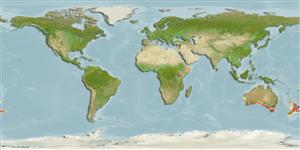Environment: milieu / climate zone / ระดับความลึก / distribution range
นิเวศวิทยา
เกี่ยวกับทะเล,น้ำเค็ม สัตว์น้ำหน้าดิน; ระดับความลึก 50 - 750 m (Ref. 6390). Subtropical; 26°S - 55°S
Southwest Pacific: Australia and New Zealand. Two forms of ocean perch are recognized in waters off New South Wales, Australia (Ref. 6390). They are referred to as 'inshore' and 'offshore' forms based on their preferred depth ranges (Ref. 6390).
A closely related species, Helicolenus barathri, is known from New Zealand and its distribution may also include southern Australian waters (Ref. 30468, 30471).
ขนาด / น้ำหนัก / Age
วัยเจริญพันธุ์: Lm ? range ? - ? cm
Max length : 47.0 cm TL เพศผู้/กระเทย; (Ref. 9563); น้ำหนักสูงสุดที่มีการรายงาน: 1.4 kg (Ref. 30476); อายุสูงสุดที่ได้รายงาน: 42 ปี (Ref. 30476)
Short description
เครื่องมือที่ใช้ในการแยกชนิดสัตว์,สิ่งมีชีวิตออกจากกัน | สัณฐานวิทยา | ความยาวต่างๆ
เงี่ยงครีบหลัง (รวม) : 12; ก้านครีบอ่อนที่หาง (รวม) : 11 - 12; เงี่ยงครีบก้น: 3; ก้านครีบอ่อนที่ก้น: 5; สัตว์มีกระดูกสันหลัง: 25.
Body shape (shape guide): fusiform / normal.
Occur on the continental shelf and slope (Ref. 9563). Two forms exist in New South Wales, Australia. The inshore form is dominant in depths less than 300 m and the offshore form is most common in deeper waters (Ref. 30468). Juveniles of both forms are caught near the edge of the continental shelf by fishers targeting royal red prawns (Haliporoides sibogae) in Australia, but their full distribution is unknown (Ref. 6390). Reproduction in ocean perch is distinctive in that fertilization is internal (Ref. 6390, 34817). Feed on squid, shrimps and fish (Ref. 6390). Head and dorsal-fin spines are venomous (Ref. 33616). Sold whole and chilled on the domestic fresh fish markets (Ref. 6390).
Life cycle and mating behavior
วัยเจริญพันธุ์ | การสืบพันธุ์ | การวางไข่ | เซลสืบพันธ์ของเพศเมีย(ไข่) | ความดกของไข่ | ตัวอ่อน
Larvae stay within the female fish until they are approximately 1 mm long before they are released into the water (Ref. 6390).
In Australia, the inshore and offshore forms of ocean perch begin mating at different times and there is a difference in the length of their larval development prior to release (Ref. 30468).
Kailola, P.J., M.J. Williams, P.C. Stewart, R.E. Reichelt, A. McNee and C. Grieve, 1993. Australian fisheries resources. Bureau of Resource Sciences, Canberra, Australia. 422 p. (Ref. 6390)
IUCN Red List Status (Ref. 130435: Version 2025-1)
Human uses
การประมง: การค้า
เครื่องมือ
Special reports
Download XML
แหล่งที่มาจากอินเตอร์เน็ต
Estimates based on models
Preferred temperature (อ้างอิง
123201): 10.5 - 16.6, mean 13 °C (based on 72 cells).
Phylogenetic diversity index (อ้างอิง
82804): PD
50 = 0.5020 [Uniqueness, from 0.5 = low to 2.0 = high].
Bayesian length-weight: a=0.01622 (0.00965 - 0.02725), b=3.12 (2.98 - 3.26), in cm total length, based on LWR estimates for this species & (Sub)family-body (Ref.
93245).
ระดับชั้นอาหาร (อ้างอิง
69278): 3.9 ±0.6 se; based on diet studies.
ความสามารถในการกลับคืนสู่ปกติ (อ้างอิง
120179): ต่ำ, เวลาต่ำสุดที่จะทำให้ประชากรเพิ่มขึ้นเป็น 2 เท่าใช้เวลา 4.5 - 14 ปี (K=0.11-0.12; tmax=42; Fec=150,000).
Fishing Vulnerability (Ref.
59153): High vulnerability (64 of 100).
🛈
Nutrients (Ref.
124155): Calcium = 59 [20, 156] mg/100g; Iron = 1.05 [0.46, 2.21] mg/100g; Protein = 17.9 [16.3, 19.7] %; Omega3 = 0.643 [0.281, 1.641] g/100g; Selenium = 42.5 [18.9, 115.9] μg/100g; VitaminA = 24.5 [8.1, 78.9] μg/100g; Zinc = 0.671 [0.378, 1.054] mg/100g (wet weight);
